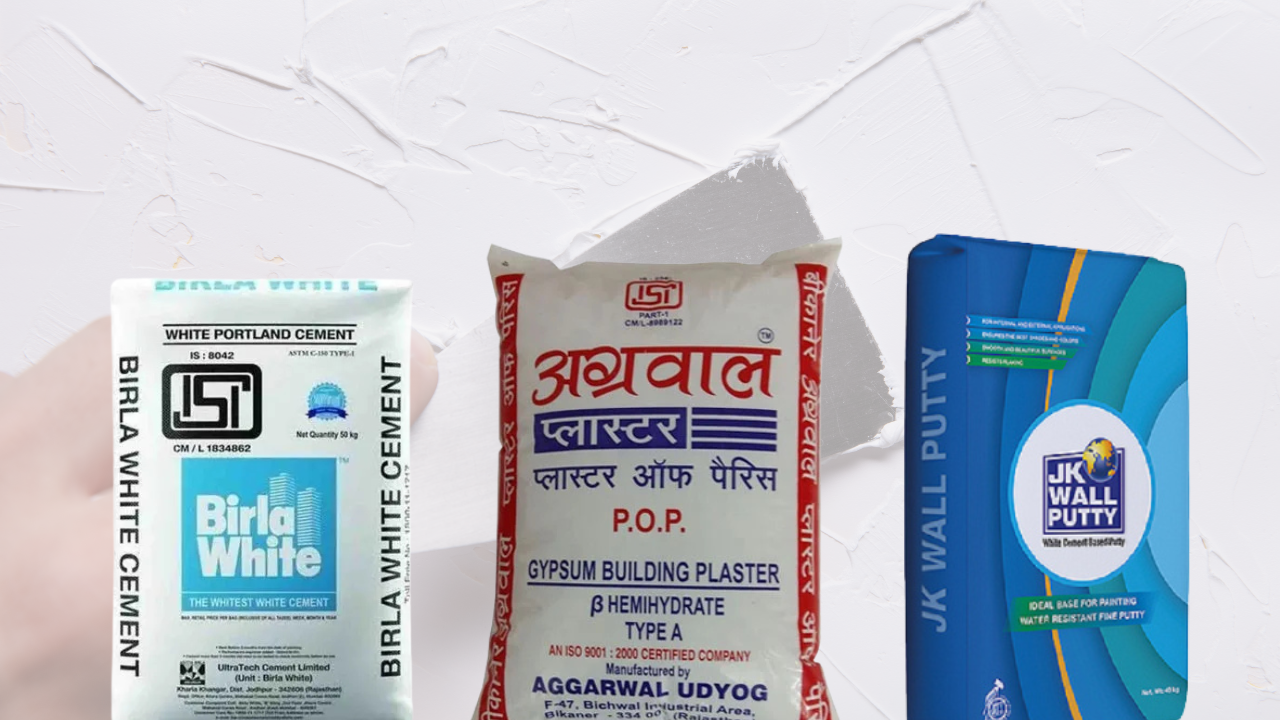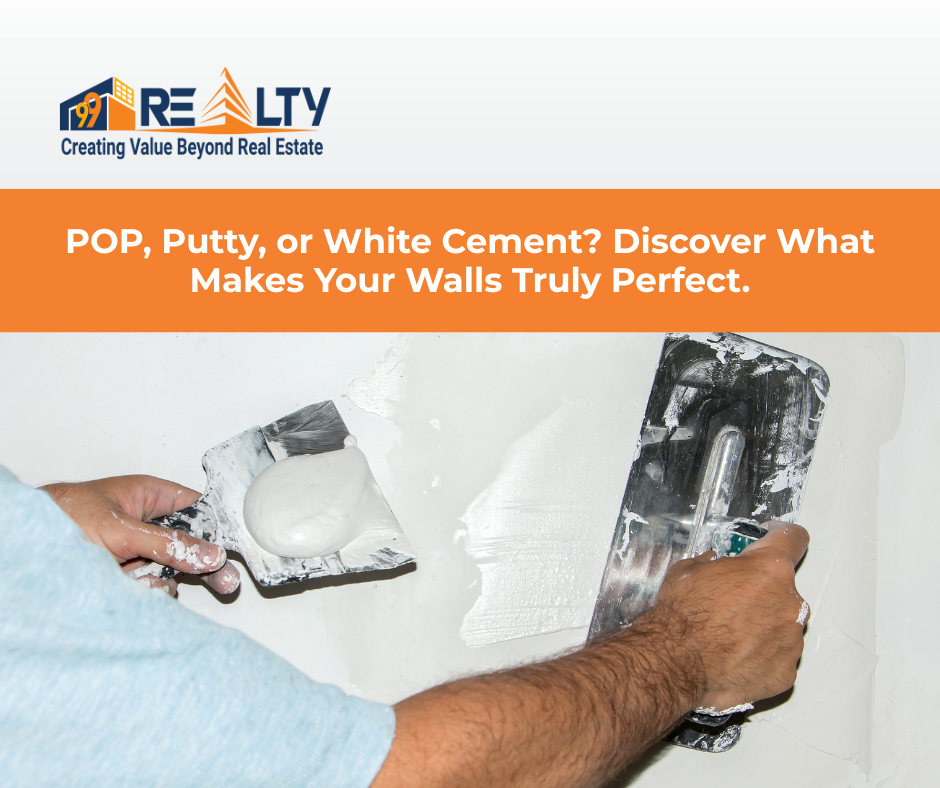Every homeowner dreams of those flawless, magazine-style walls — smooth, spotless, and perfectly painted. But achieving that “perfect painted wall” isn’t just about premium paint brands or vibrant colors.
The real magic lies beneath the paint layer — in the materials that prepare base, smoothens, and strengthen your walls.
This is where the best selection between Plaster of Paris (POP), Wall Putty or White Cement come into play. Though they might look similar in a bag, they behave very differently once on your wall. Let’s find out each one and help you decide which material is best for your dream home.
Branded Vs Local Developers/Builders : Which One Truly Delivers Value?
The Science Behind a Perfect Wall Finish
Why Wall Surface Preparation Is Crucial
Imagine trying to paint on a rough rock instead of a smooth canvas. The texture, absorption, and evenness of a wall’s surface determine how well your paint grips and how beautiful it looks afterward. A properly prepared surface ensures:
- Even paint absorption (no patchy or faded zones)
- Longer paint life
- Resistance against cracks and peeling
What Happens Beneath the Paint
When you paint over a poorly prepared wall, moisture, dust, or air pockets trapped underneath start causing trouble. The paint begins to bubble, crack, or discolor within months. That’s why professionals always emphasize building a solid base layer — and that base depends on the right material.
Deep Dive: What Is Plaster of Paris (POP)?
Origin and Composition
Plaster of Paris is made from gypsum (CaSO₄·½H₂O) — a naturally occurring mineral. When gypsum is heated at around 150°C, it loses water molecules and turns into a fine white powder called POP.
Technical Features and Chemical Behavior
When mixed with water, POP undergoes an exothermic reaction that hardens it back into gypsum form. This reaction happens quickly — within 10 to 20 minutes — making it perfect for decorative and detailed work. It provides:
- High smoothness
- Non-shrinking quality
- Lightweight coverage
About POP Punning Technique
POP punning is a finishing technique in which a thin layer of Plaster of Paris (POP) is applied over plastered walls or ceilings to create a smooth, level, and visually appealing surface. It helps conceal minor cracks, undulations, and surface imperfections while providing a strong base for paint or wallpaper. A properly executed POP layer not only enhances the aesthetic appeal but also improves the wall’s durability and paint adhesion, resulting in a long-lasting, premium finish.
Advantages of Using POP
- Seamless finish: Ideal for intricate ceiling designs and cornices.
- Customizable: Can be molded into artistic shapes easily.
- Thermal insulation: Helps maintain indoor temperature.
- Quick setting: Saves time during interior finishing.
Drawbacks and Ideal Usage Conditions
- Sensitive to moisture: POP loses strength in damp areas.
- Low mechanical strength: Not suitable for load-bearing walls.
- Short working time: Needs skilled professionals to handle quickly.
Best used for: Interior ceilings, false ceilings, wall décor.

Exploring Wall Putty
Composition and Types (Acrylic vs Cement-Based)
Wall putty is a fine blend of white cement, polymers, and minerals that creates a smooth and strong base before painting. There are two main types:
- Acrylic Putty: Pre-mixed, smooth, and easy to apply — perfect for interiors.
- Cement-Based Putty: Powder-based, water-mixable, and far more durable — suitable for both interiors and exteriors.
Why Wall Putty Is the Modern Homeowner’s Favorite
- Strong adhesion: Bonds firmly to cement plaster and old walls.
- Prevents flaking: Keeps paint looking fresh for years.
- Water resistance: Especially the cement-based variant.
- Paint-ready surface: Reduces paint consumption by providing a smoother layer.
How to Apply Wall Putty for Best Results
- Clean the surface thoroughly — remove dust, oil, and loose paint.
- Apply the first coat in a thin layer using a steel trowel.
- Allow drying for at least 8–10 hours.
- Sand lightly and apply the second coat for perfection.
- After full drying (24–48 hours), apply primer and then paint.
Mistakes to Avoid
- Don’t apply putty on a wet surface — it weakens adhesion.
- Avoid very thick layers — it leads to cracks.
- Never skip primer before painting.
Understanding White Cement
How It’s Made and Its Unique Composition
White cement is produced similarly to grey cement but with low-iron limestone and special clays. These raw materials prevent color impurities, giving it its bright white shade. It’s also mixed with alumina and manganese to enhance strength and brightness.
Properties That Make White Cement Different
- High compressive strength
- Better adhesion on both concrete and plaster
- Reflective surface that enhances light
- Acts as a base and decorative material simultaneously
Benefits and Applications
- Durability: Withstands heat, rain, and humidity.
- Versatility: Used for flooring, facades, sculptures, and base coating.
- Reflectivity: Brightens dark interiors and makes colors pop.
- Moisture resistance: Helps protect walls in damp climates.
- Best for textured wall designs.
- It can offer a bright and pure white colour that is not possible to achieve with traditional paints.
Wall Colour Secrets for Indian Homes: Avoid These Mistakes
Limitations and Compatibility Issues
- Expensive compared to POP or putty
- Needs precise mixing ratio for smooth finish
- Can cause uneven shades if not applied evenly
Best used for: Exterior walls, bathrooms, or as base for high-end finishes.
POP vs Putty vs White Cement: Head-to-Head Comparison
| Feature | Plaster of Paris (POP) | Wall Putty | White Cement |
|---|---|---|---|
| Base Material | Gypsum | White cement + polymers | Refined white clinker |
| Durability | Moderate | High | Very High |
| Smoothness | Excellent | Very Good | Good |
| Water Resistance | Poor | Good | Excellent |
| Application Area | Interior | Interior & Exterior | Both |
| Drying Time | 15–30 mins | 8–10 hours | 24 hours |
| Cost | ₹20–₹40/kg | ₹35–₹60/kg | ₹50–₹90/kg |
| Skill Requirement | High | Medium | High |
| Eco-Friendliness | Medium | High | Moderate |
Strength, Durability, and Longevity
White cement clearly wins for toughness and resistance. It bonds deeply and forms a rock-solid base. Wall putty comes second — strong yet flexible, ideal for most homes. POP, though smooth, is more decorative than structural.
Finish and Aesthetic Appeal
If “luxury look” is your goal, POP delivers unmatched smoothness. For everyday walls, putty gives a balanced finish with easier maintenance.
Application Process and Drying Time
POP is fast-setting but needs expertise; wall putty gives more working time; white cement takes longest but ensures structural stability.
Moisture and Weather Resistance
In humid cities like Mumbai or Chennai, white cement or cement-based putty is best. POP should never touch moisture-heavy surfaces.
Cost Efficiency and Maintenance
While POP is cheaper, repairs can be frequent. Putty offers great long-term value. White cement, though costly, minimizes repainting expenses.
Environmental Impact
Modern wall putties are eco-friendly, with low VOCs and minimal waste. POP manufacturing emits more carbon, while white cement’s production is energy-intensive but recyclable.
Choosing the Right Material for Every Part of Your Home
Interior Walls
Use cement-based wall putty followed by primer. It gives a glossy, flawless surface perfect for decorative paints and textures.
Exterior Walls
Opt for white cement or exterior-grade putty. They handle weather variations and resist mold, dust, and dampness.
Kitchens, Bathrooms, and Damp Areas
Go for white cement base, as it resists moisture better than POP or acrylic putty.
Decorative and Designer Surfaces
POP remains unbeatable for artistic ceilings, arches, and moldings due to its moldability and soft texture.
Expert Tips to Achieve a Perfect Wall Finish
Preparing the Surface Like a Pro
Always ensure the plaster beneath is fully cured (at least 28 days for cement walls). Trapped moisture leads to future cracks.
Layering Techniques for Longevity
Use multiple thin coats instead of one thick layer. Allow each coat to dry completely before applying the next — patience pays off.
Timing and Curing – The Often-Ignored Step
Never rush painting. Let the putty or POP cure for 2–3 days. For white cement, wait 7 days for best results.
Expert Recommendation
For modern Indian homes:
- Use white cement or cement-based wall putty as a base layer.
- Use POP only for ceilings and detailed designs.
- Always finish with primer and high-quality paint.
This combination delivers a perfect balance of strength, durability, and beauty — keeping your walls looking brand-new for years.
Materials Matter, But Technique Wins The Day
Even the best white cement, putty, or POP will fail without skilled hands and proper workmanship — so don’t skimp on the person doing the job. Hire a reputable ‘thikedar’ (contractor/mason) who knows surface prep, layering, and finishing details; experience matters when it comes to feathering edges, applying thin even coats, and getting sanding right. Simple tasks like careful sandpapering between coats, using the right grit, and applying multiple thin layers instead of one thick slap-on make the difference between a finish that lasts and one that peels or cracks. In short: invest in good skills and supervision, don’t fall for the cheap work, check their past work and insist on the right techniques — it’s the single best way to protect your investment and get the flawless wall finish you paid for.
Conclusion
When it comes to making your home wall print perfect, the right foundation material can make or break your results.
- Choose POP if you love artful ceilings and elegant interiors.
- Choose Wall Putty for smooth, practical, long-lasting surfaces.
- Choose White Cement if you live in a humid climate or want rock-solid durability.
Think of it like choosing a good skincare routine for your house — cleanse, treat, and protect. The better you treat your walls now, the longer they’ll glow with perfection.
Disclaimer : This article is for informational purposes only and does not promote or endorse any specific brand of wall putty, plaster of Paris, or white cement. The image used are for illustrative purposes to help readers understand the topic better.
Need Help?
Need help evaluating a property or planning your next move in the market?
Reach out to 99 REALTY – your trusted real estate partner for smarter choices.
Subscribe to get updates on our latest posts and market trends.






Join The Discussion